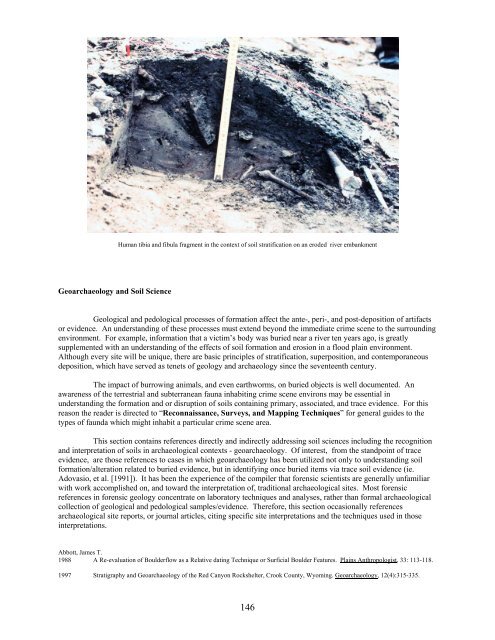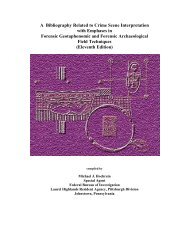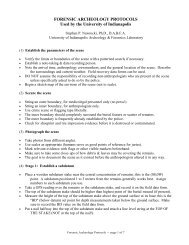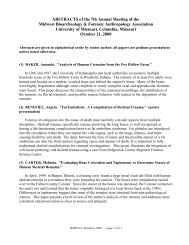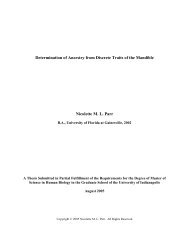- Page 1 and 2:
A Bibliography Related to Crime Sce
- Page 3 and 4:
Trace and Impression Evidence . . .
- Page 5 and 6:
Introduction The following bibliogr
- Page 7 and 8:
This bibliography is not annotated
- Page 9 and 10:
Planning and Reconnaissance Line se
- Page 11 and 12:
2000b Hazards and a Crime Scene. ht
- Page 13 and 14:
Getty, Robert 1975 Sisson and Gross
- Page 15 and 16:
Kelland, N.C. 1991 Acoustics as an
- Page 17 and 18:
Nicholson, B.A. 1983 A Comparative
- Page 19 and 20:
Scott, Douglas D. 2000 Identifying
- Page 21 and 22:
Western Australian Police Departmen
- Page 23 and 24:
Allan, Arthur Laidlaw, J.R. Hollwey
- Page 25 and 26:
Brown, KA. Robson, A. Chalmers, T.
- Page 27 and 28:
Falkner, Edgar 1995 Aerial Mapping:
- Page 29 and 30:
Hope-Taylor, B. 1966 Archaeological
- Page 31 and 32:
Lohner, Al. 2002 Crime Scene Diagra
- Page 33 and 34:
Piggott, S., and B. Hope-Taylor 196
- Page 35 and 36:
Sipe, F. Henry 1979 Compass Land Su
- Page 37 and 38:
Wolf, Paul R. and Russell C. Brinke
- Page 39 and 40:
Aerial Photography and Photogrammet
- Page 41 and 42:
Cooke, F.B.M. and J.S. Wacher 1970
- Page 43 and 44:
Lloyd, Harvey 1990 Aerial Photograp
- Page 45 and 46:
Stout, Kristen K. 1998 Historical A
- Page 47 and 48:
Besant-Matthews, Patrick 1999 Consi
- Page 49 and 50:
Gui Qiang, W. 1996 Detecting and En
- Page 51 and 52:
March, Jack, Damian Schofield, Mart
- Page 53 and 54:
Sanger, David 1973 Extreme Closeup
- Page 55 and 56:
Whalen, D.H., and F.A. Blanchard 19
- Page 57 and 58:
Dorwin, J.T. 1967 Iodine Staining a
- Page 59 and 60:
Reis, George 2003 Digital Imaging,
- Page 61 and 62:
Canines Cody (left) and Cinder (rig
- Page 63 and 64:
Chin, Shirley S., and Kenneth G. Fu
- Page 65 and 66:
Hess, R. 1991 Forming of a Canine U
- Page 67 and 68:
Pearsall, Milo D., and Hugo Verbrug
- Page 69 and 70:
Thomas Jr., R.B. 1989 Use of Canine
- Page 71 and 72:
Ground penetrating radar used in th
- Page 73 and 74:
n.d. Ground Penetrating Radar. Geol
- Page 75 and 76:
Fischer, P.M., Sven G.W. Follin, an
- Page 77 and 78:
Neubauer, W., A. Eder-Hinterleitner
- Page 79 and 80:
Infrared thermography survey from a
- Page 81 and 82:
1989 Detecting the Defects. Civil E
- Page 83 and 84:
1992 Magnestische Prospektion im Ja
- Page 85 and 86:
Dubois, R.L. 1989 Archeomagnetic Re
- Page 87 and 88:
Jordanova, Neli, Eduard Petrovsky,
- Page 89 and 90:
1999 Introduction: Magnetism and Si
- Page 91 and 92:
Athens, William P. 1984 Remote Sens
- Page 93 and 94:
Department of Foreiign Affairs and
- Page 95 and 96:
Haupt, P. 1997 1,000,000km 2 KVR-10
- Page 97 and 98:
Martin, William A., James E. Bruset
- Page 99 and 100: Roybal, L.G., R.A. Hyde, and N.E. J
- Page 101 and 102: United States National Oceanic and
- Page 103 and 104: Bevan, Bruce W., David G. Orr, and
- Page 105 and 106: Davenport, G. Clark 1989 Forensic G
- Page 107 and 108: Fischer, P.M. 1980 Geophysical Pros
- Page 109 and 110: Kamei, Hiroyuki, Yuzo Marukawa, Hir
- Page 111 and 112: McCormick, John 1999 A High-Tech Se
- Page 113 and 114: Reynolds, John M. 1997 An Introduct
- Page 115 and 116: Tonkov, N. 1996 Geophysical Survey
- Page 117 and 118: Investigators conduct a forensic ar
- Page 119 and 120: Baker, Charles M. 1978 The size eff
- Page 121 and 122: Boddington, A., A.N. Garland, and R
- Page 123 and 124: Combes, J.D. 1964 A Graphic Method
- Page 125 and 126: Dirkmaat, Dennis C. 1991 Applicatio
- Page 127 and 128: Eyman, Charles E. 1965 Ultraviolet
- Page 129 and 130: Gumerman, George, IV, and Bruce S.
- Page 131 and 132: 1998 An Autopsy of the Grave: The P
- Page 133 and 134: Kanable, Rebecca 2002 Talk n' Trash
- Page 135 and 136: Mac Neish, Richard S. 1978 The Scie
- Page 137 and 138: Moore-Jansen, P.H. and R.L. Jantz 1
- Page 139 and 140: Parnell, J.P.M. 1966 The Techniques
- Page 141 and 142: Rathje, William L. and Michael B. S
- Page 143 and 144: 1993 Archaeological Method and Theo
- Page 145 and 146: Spriggs, J.A. 1989 On and Off-Site
- Page 147 and 148: Van Horn, David M. 1988 Mechanized
- Page 149: Woodall, J. Ned 1972 An Introductio
- Page 153 and 154: Bates, T.E. 1993 Soil Handling and
- Page 155 and 156: Breuning-Madsen, H., J. Rønsbo, an
- Page 157 and 158: 1958 Soils for the Archaeologist. P
- Page 159 and 160: Drucker, P. 1972 Stratigraphy in Ar
- Page 161 and 162: Ferring, C. Reid 1986 Rates of Fluv
- Page 163 and 164: Golley, F.B., L. Ryszkowski, and J.
- Page 165 and 166: Hiraoka, Yoshihiro and T. Mitsuji 1
- Page 167 and 168: Keeley, H.C.M., G.E. Hudson, and J.
- Page 169 and 170: Leonardi, Giovanni, Mara Miglavacca
- Page 171 and 172: Mattingly, G.E.G., and R.J.B. Willi
- Page 173 and 174: 2004 Scientific Crime Scene Investi
- Page 175 and 176: Rapp, J.S. 1987 Forensic Geology an
- Page 177 and 178: Scudder, Sylvia 2003 Sea Level Rise
- Page 179 and 180: 1992 Organic Matter in Archaeologic
- Page 181 and 182: Villa, Paola and Jean Courtin 1983
- Page 183 and 184: 1977 The Quantitative Analysis of S
- Page 185 and 186: Decomposition Scatter of skeletal e
- Page 187 and 188: Bass, William M., Robert W. Mann, a
- Page 189 and 190: 1981a Parts of the Skeleton: Surviv
- Page 191 and 192: Child, A., R. Gillard, and A. Polla
- Page 193 and 194: de Jongh, D.S., J.W. Leftis, J.S. G
- Page 195 and 196: 1992 Chemical Investigation of a Bo
- Page 197 and 198: Grupe, G., and U. Dreses-Werringloe
- Page 199 and 200: Hess, M.W., G. Klima, K. Pfaller, K
- Page 201 and 202:
Kerbis, J., R. Wrangham, M. Carter,
- Page 203 and 204:
Lam, Y.M., X. Chen, and O.M. Pearso
- Page 205 and 206:
Malainey, M.E., R. Przybylski, and
- Page 207 and 208:
1996 A Diffusion-Adsorption Model o
- Page 209 and 210:
O’Brien, Tyler G. 1993 Waxing Gra
- Page 211 and 212:
1989 Examples of Chemical Change Du
- Page 213 and 214:
Rothschild, M.A., V. Schmidt, and V
- Page 215 and 216:
Sorg, Marcella H., J.H. Dearborn, K
- Page 217 and 218:
Thali, M.J., K. Yen, W. Scweitzer,
- Page 219 and 220:
Villiers, H. de, and M.L. Wilson 19
- Page 221 and 222:
Disease and Illness Aaron, Jean E.,
- Page 223 and 224:
1994 Vertebral Arthritis and Physic
- Page 225 and 226:
1999 Children of the Poor: Life in
- Page 227 and 228:
Mays, S., G.M. Taylor, A.J. Legge,
- Page 229 and 230:
Ortner, D.J., and G. Theobald 1993
- Page 231 and 232:
Saul, Julie Mather and Frank P. Sau
- Page 233 and 234:
Watkins, R.L., A.J. Hankin, and M.E
- Page 235 and 236:
Birkby, Walter H. 1976 Cremated Hum
- Page 237 and 238:
Eckert, W.G., S. James, and S. Katc
- Page 239 and 240:
Leechman, Douglas 1951 Bone Grease.
- Page 241 and 242:
Pope, Elayne J., Steven A. Symes, O
- Page 243 and 244:
Walshe, K. 1987 The Burnt Bone from
- Page 245 and 246:
Berryman, Hugh E. 2002 Disarticulat
- Page 247 and 248:
Grice, Gordon 2001 Is that a Mounta
- Page 249 and 250:
Marean, C.W., L. Spencer, R.J. Blum
- Page 251 and 252:
Sobbe, I.H. 1990 Devils on the Darl
- Page 253 and 254:
Sharp, Blunt, Ballistic and Other T
- Page 255 and 256:
Bass, W.M. 1983 The Occurrence of J
- Page 257 and 258:
1998 Child Abuse, in B.G. Brogdon,
- Page 259 and 260:
Christensen, Angi M. 2004 The Influ
- Page 261 and 262:
Deegear, Gary S. 2004 Power Tool In
- Page 263 and 264:
Evans, F.G. 1973 Mechanical Propert
- Page 265 and 266:
Gestring, Mark L., Vicente H. Graci
- Page 267 and 268:
Harkness, James, William Ramsey, an
- Page 269 and 270:
Hunt, A.C., and V.M. Kon 1962 The P
- Page 271 and 272:
Kassirer, M.D. 1991 Farearms and th
- Page 273 and 274:
Lambert, Patricia M., Brian R. Bill
- Page 275 and 276:
Mallam, R. Clark 1979 A Cut and Per
- Page 277 and 278:
Melbye, J., and S.I. Fairgrieve 199
- Page 279 and 280:
Neupert, E.A., and S.B. Boyd 1991 R
- Page 281 and 282:
Pollak, S., and F. Ritt 1992 Compar
- Page 283 and 284:
Rhee, Peter M., Amy Bridgeman, Jose
- Page 285 and 286:
Saul, Julie Mather, and Frank P. Sa
- Page 287 and 288:
Smith, M.J., and M.B. Brickley 2004
- Page 289 and 290:
Stubblefield, Phoebe R. 1999 Homici
- Page 291 and 292:
Traqui, A., K. Fonmartin, A. Gérau
- Page 293 and 294:
Vogel, Hermann, and B.G. Brogdon 20
- Page 295 and 296:
Wilson, J.M. 1978 Shotgun Ballistic
- Page 297 and 298:
Berry, J. 1979 Ridge Detail in Natu
- Page 299 and 300:
Schmidt, Christopher, Stephen Nawro
- Page 301 and 302:
Binford, Lewis Roberts 1981 Bones:
- Page 303 and 304:
Fairgrieve, Scott I. and Tracy S. O
- Page 305 and 306:
Hoover, Peter R. 1981 Paleontology,
- Page 307 and 308:
1977 History of Forensic Dentistry.
- Page 309 and 310:
Piedalue, Gisele, and Jerome S. Cyb
- Page 311 and 312:
Skinner, Mark F. 1988a Dental Evide
- Page 313 and 314:
2004 International Research in Fore
- Page 315 and 316:
Adair, Thomas, W. 1999a Three Speci
- Page 317 and 318:
2004 The Effect of Time After Body
- Page 319 and 320:
Benecke, M., L. Barksdale, J. Sunde
- Page 321 and 322:
Brusven, M.A., and A.C. Scoggan 196
- Page 323 and 324:
Chapman, R.K. and J.H.P. Sankey 195
- Page 325 and 326:
Davies, L., and G.G. Ratcliffe 1994
- Page 327 and 328:
1989a Entomology, Zoology and Foren
- Page 329 and 330:
Girling, M.A. 1989 The Insect Fauna
- Page 331 and 332:
1990a Behavior of Postfeeding Larva
- Page 333 and 334:
Haskell, Neal H., and Gary Dale 200
- Page 335 and 336:
Hu, C., and Y.K. Ma 1995 The Past,
- Page 337 and 338:
Kenward, H.K. 1975a Pitfalls in the
- Page 339 and 340:
Lane, R.P. 1975 An Investigation in
- Page 341 and 342:
Lord W.D., R.W. Johnson, and F. Joh
- Page 343 and 344:
Mc Knight, B.E. 1981 The Washing Aw
- Page 345 and 346:
Myskowiak, J.-B., B. Chauvet, T. Pa
- Page 347 and 348:
2001 New Records for Ancient Pests:
- Page 349 and 350:
1997 Forensic Entomology Case Study
- Page 351 and 352:
Sadler, D.W., J. Richardson, S. Hai
- Page 353 and 354:
Simpson, G., and D.B. Strongman 200
- Page 355 and 356:
Stevens, Jamie, and Richard Wall 20
- Page 357 and 358:
Vannote, R.L., and B.W. Sweeney 198
- Page 359 and 360:
Wells, Jeffrey D. 2003a Quality Con
- Page 361 and 362:
Zwick, P. 1979 Contributions to the
- Page 363 and 364:
Algology, Diatomology, and Limnolog
- Page 365 and 366:
Tamaska, L. 1949 Diatom Content of
- Page 367 and 368:
Tsujikawa, Kenji, Tatsuyuki Kanamor
- Page 369 and 370:
1963b Pollen Analysis. In Science i
- Page 371 and 372:
1994a Palynology in Historical Rura
- Page 373 and 374:
Sobolik, K.D. 1988 The Importance o
- Page 375 and 376:
Anonymous 1975 Wood as Evidence. FB
- Page 377 and 378:
Carruthers, W.J. 1989 Mineralised P
- Page 379 and 380:
Frey, G.D. 1955 A Differential Flot
- Page 381 and 382:
1963 Palaeo-Ethnobotany. In Science
- Page 383 and 384:
Lipscomb, B.L., and G.M. Diggs, Jr.
- Page 385 and 386:
Pearsall, Deborah M. n.d Paleoethno
- Page 387 and 388:
Smetanka, Mary Jane 1998 Taxonomist
- Page 389 and 390:
1982 Problems of Interpretation of
- Page 391 and 392:
DNA Evidence Abaz, J., S.J. Walsh,
- Page 393 and 394:
Banerjee, Monica, and Terence A. Br
- Page 395 and 396:
Butler, John M. 2001a Forensic DNA
- Page 397 and 398:
Davoren, Jon, Daniel Vanek, John D.
- Page 399 and 400:
Gaensslen, R.E., and Henry C. Lee 1
- Page 401 and 402:
Harvey, Michele, and Mary-Claire Ki
- Page 403 and 404:
Jeffreys, Alec J. 1993 DNA Typing:
- Page 405 and 406:
Latham, Krista E., Jennifer L. Harm
- Page 407 and 408:
Mameli, A., D. My, A. Mattei, V. No
- Page 409 and 410:
National Research Council Committee
- Page 411 and 412:
Raoult, D., G. Aboudharam, E. Crub
- Page 413 and 414:
Sensabaugh, G.F., A.C. Wilson, and
- Page 415 and 416:
Thomas, M., P. Gilbert, E. Willersl
- Page 417 and 418:
Whitaker, J., P. Gill, E. Cotton, A
- Page 419 and 420:
Bevel, Virgil Thomas, and Ross M. G
- Page 421 and 422:
Harboe, M. 1959 A Method for Determ
- Page 423 and 424:
Niebauer, Joseph C., Jack B. Booth,
- Page 425 and 426:
Other Blood and Body Fluid Topics U
- Page 427 and 428:
Hatch, A.L. 1993 A Modified Reagent
- Page 429 and 430:
Loy, Thomas H. and Andree R. Wood 1
- Page 431 and 432:
Sutton, T.P. 1999 Presumptive Blood
- Page 433 and 434:
Heizer, Robert F. 1967 Analysis of
- Page 435 and 436:
Hair and Feather Evidence Sampling
- Page 437 and 438:
Chase, H.B., and A.F. Silver 1969 B
- Page 439 and 440:
Halverson, Joy L., Leslie Lyons 200
- Page 441 and 442:
Kupferschmid, T.D., R. Van Dyke and
- Page 443 and 444:
Olsen, E.A., editor 1994 Disorders
- Page 445 and 446:
Serowik, J.M. and W.F. Rowe 1987 Bi
- Page 447 and 448:
Wilson, A.S. 1998 Hair Today. Gone
- Page 449 and 450:
1998 A Computerized Data Base of Ma
- Page 451 and 452:
2000b A Survey on the Evidential Va
- Page 453 and 454:
Masakowski, S., B. Enz, J.E. Cother
- Page 455 and 456:
Strzelczyk, A.B., L. Bannach, and A
- Page 457 and 458:
1936c The Reproduction of Original
- Page 459 and 460:
1994b Physical Developer: A Chemica
- Page 461 and 462:
Gamboe, T.E. 1994 Identification of
- Page 463 and 464:
Hewitt, Deborah A., and Kevin J. By
- Page 465 and 466:
Lafrance, G. 1976 Reproduction of I
- Page 467 and 468:
Norman, John C. 2004 A Porcine Mode
- Page 469 and 470:
Stowell, Leena I., and Kay A. Card
- Page 471 and 472:
Tool Mark Impression Evidence Denta
- Page 473 and 474:
Dean, William L. 1987 A Case Involv
- Page 475 and 476:
Qi, Ao 2003 Experimental Research o
- Page 477 and 478:
Anthony, Arthur T., Betty C. Gayton
- Page 479 and 480:
Cowan, M.E. 1986 Trace Evidence, Tr
- Page 481 and 482:
Heron, C., R.P. Evershed, and L.J.
- Page 483 and 484:
Meng, H., and B. Caddy 1997 Gunshot
- Page 485 and 486:
Stone, I.C., J.N. Lomonte, L.A. Fle
- Page 487 and 488:
Mass Fatality and Human Rights Inve
- Page 489 and 490:
1990 The Department of Transport Ai
- Page 491 and 492:
Holland, Thomas D., William E. Gran
- Page 493 and 494:
Nelson, Kurt R. 1999 Mass Transit:
- Page 495 and 496:
Mass Graves Abarinov, V. 1993 The M
- Page 497 and 498:
1998b Forensic Monitoring Project F
- Page 499 and 500:
Haglund, William D., Melissa Connor
- Page 501 and 502:
Owsley, Douglas W. Davor Strinovic,
- Page 503 and 504:
Snow, Charles E. 1948 The Identific
- Page 505 and 506:
Allen, E.W. 1995 Scenes from the Ok
- Page 507 and 508:
Bernstein, M.L., G.R. Nichols, J.D.
- Page 509 and 510:
Byrd, Mike n.d. Lost Innocents. htt
- Page 511 and 512:
De Bruycker, M., D. Greco, I. Annin
- Page 513 and 514:
Fletcher, Robert P. Jr. 1990 The Un
- Page 515 and 516:
Hampl, Peter F. 2001 The Use of "Ta
- Page 517 and 518:
Kirschner, Robert H. 1984 The Use o
- Page 519 and 520:
Lorton, L., M. Rethman, and R. Frie
- Page 521 and 522:
Morris, B.A.P., and T.M. Armstrong
- Page 523 and 524:
Perper, J. 1990 Catastrophes Et Mor
- Page 525 and 526:
Scott, Douglas 1993 Firearm Identif
- Page 527 and 528:
Strobel, Richard 1998 Recovery of M
- Page 529 and 530:
Ursano, R.J., C.S. Fullerton, K. Va
- Page 531 and 532:
Yinon, J., and S. Zitrin 1993 Moder
- Page 533 and 534:
Arnold, Bettina, and Nancy L. Wicke
- Page 535 and 536:
1993 Hmong Death Customs: Tradition
- Page 537 and 538:
Cragg, K. 1983 Finality in Islam. S
- Page 539 and 540:
Goodman, A.M. 1981 A Plain Pine Box
- Page 541 and 542:
Jackson, M. 1972 The Black Experien
- Page 543 and 544:
Lincoln, Bruce 1991 Death, War and
- Page 545 and 546:
Morgan, Ernest and Jennifer Morgan
- Page 547 and 548:
Polfer, Michel, and Jos Thiel 1997
- Page 549 and 550:
Saunders, Shelley R., and Ann Herri
- Page 551 and 552:
Tuckwell, A. 1975 Patterns of buria
- Page 553 and 554:
Criminal and Cultural Behavior The
- Page 555 and 556:
Boudreaux, M.C., W.D. Lord, and R.L
- Page 557 and 558:
Dietz, P.E. 1986 Mass, Serial and S
- Page 559 and 560:
Geberth, Vernon J. 1981 Psychologic
- Page 561 and 562:
Hayes, W.A. 1980 Radical black beha
- Page 563 and 564:
Jerath, Bal K., Paul E. Larson, and
- Page 565 and 566:
Logan, M. 1995 Mothers Who Murder:
- Page 567 and 568:
Myers, Wade C. 2001 Juvenile Sexual
- Page 569 and 570:
Ritter, B. 1988 The Characteristics
- Page 571 and 572:
Skrapec, C. 1996 The Sexual Compone
- Page 573 and 574:
Websdale, Neil 1999 Understanding D
- Page 575 and 576:
General Crime Scene and Death Scene
- Page 577 and 578:
Baldwin, Hayden B. 2000 The Recover
- Page 579 and 580:
Caddy, Brian (editor) 1987 Uses of
- Page 581 and 582:
Dawidson, Irena 2003 Repositories o
- Page 583 and 584:
Evans, Colin 1996 The Casebook of F
- Page 585 and 586:
Gee, D.J. 1988 A Pathologist’s Vi
- Page 587 and 588:
2002 A Bibliography Related to Geot
- Page 589 and 590:
Karelse, J.W. 2003 Science, Crime S
- Page 591 and 592:
Marks, Murray K. 2003 The Universit
- Page 593 and 594:
Nyberg, Ramesh 1998 Cracking barcod
- Page 595 and 596:
Recheis, Wolfgang, and Ferdinand Fr
- Page 597 and 598:
1977 Homicide Investigation: Practi
- Page 599 and 600:
2000a Crime Scene Investigation, AG
- Page 601 and 602:
Wilson, C. 1989 Written in Blood: A
- Page 603 and 604:
Cox, Mike 1991 The Confessions of H
- Page 605 and 606:
Miller, Tom 1993 The Copeland Killi
- Page 607 and 608:
Williams, Paul, and Bryce L. Marsha
- Page 609 and 610:
Beggs, G.J. 1995 Novel Expert Evide
- Page 611 and 612:
Galloway, A., W.H. Birkby, T. Kahan
- Page 613 and 614:
Klawans, Harold L. 1991 Trials of a
- Page 615 and 616:
Pendleton, Herbert F. 2002 Higher E
- Page 617 and 618:
2004b Daubert Factors Applied to th
- Page 619 and 620:
American Academy of Forensic Scienc
- Page 621 and 622:
Metro-Dade Police Department Crime
- Page 623 and 624:
Footwear and Shoeprints: General In
- Page 625 and 626:
The German Forensic Odontology Soci
- Page 627 and 628:
Forensic Entomology Data Form http:


